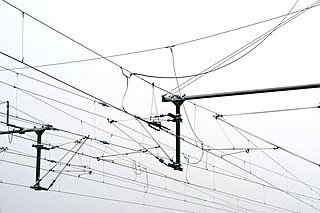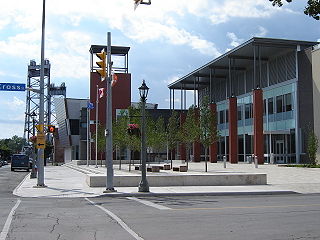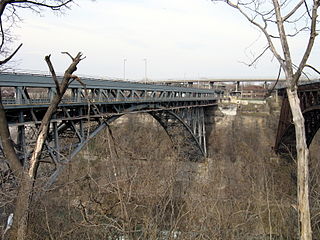
An overhead line or overhead wire is an electrical cable that is used to transmit electrical energy to electric locomotives, trolleybuses or trams. It is known variously as:

Welland is a city in the Regional Municipality of Niagara in Southern Ontario, Canada. In 2016, it had a population of 52,293.

Fort Erie is a town on the Niagara River in the Niagara Region, Ontario, Canada. It is directly across the river from Buffalo, New York and is the site of Old Fort Erie which played a prominent role in the War of 1812.

Old Fort Erie, also known as Fort Erie, or the Fort Erie National Historic Site of Canada, was the first British fort to be constructed as part of a network developed after the Seven Years' War was concluded by the Treaty of Paris (1763), at which time France ceded its territories east of the Mississippi River to Great Britain. The installation is located on the southern edge of what is now the Town of Fort Erie, Ontario, directly across the Niagara River from Buffalo, New York, United States.
Chippawa is a community located within the city of Niagara Falls, Ontario.

The Whirlpool Rapids Bridge, commonly known as the Whirlpool Bridge or the Lower Steel Arch Bridge, is a spandrel braced, riveted, two-hinged arch bridge that crosses the international border between Canada and the United States, connecting the commercial downtown districts of Niagara Falls, Ontario and Niagara Falls, New York. This bridge is located approximately 1.5 kilometres (0.9 mi) north of the Rainbow Bridge and about 2 kilometres (1.2 mi) from the Falls. It was acquired by the Niagara Falls Bridge Commission in January 1959. Immediately upstream is the similar arch-style Michigan Central Railway Bridge, which has been out of service since 2001.
Ridgeway is a small, unincorporated village in Fort Erie, Ontario, Canada. The community is within the Niagara Regional Municipality. It used to be the seat of government for Bertie Township within Welland County. Ridgeway is now a part of the Town of Fort Erie. In recent years the rail line has been converted to a walking and cycling trail, part of a trail system circling the Niagara region.
The Toronto Suburban Railway was a Canadian electric railway operator with local routes in west Toronto, and a radial (interurban) route to Guelph.
The Buffalo and Niagara Falls Railroad was a part of the New York Central Railroad system, connecting Buffalo, New York to Niagara Falls. It is still used by CSX for freight and Amtrak for passenger service.

The Canada Southern Railway, also known as CSR, was a railway in southwestern Ontario, Canada, founded on February 28, 1868 as the Erie and Niagara Extension Railway. Its name was changed to Canada Southern Railway on December 24, 1869. The 1868 Act specified that it was to be constructed at a broad gauge of 5 ft 6 in, but that requirement was repealed in the 1869 Act, thus allowing construction at the standard gauge of 4 ft 8+1⁄2 in.

The International Railway Company (IRC) was a transportation company formed in a 1902 merger between several Buffalo-area interurban and street railways. The city railways that merged were the West Side Street Railway, the Crosstown Street Railway and the Buffalo Traction Company. The suburban railroads that merged included the Buffalo & Niagara Electric Street Railway, and its subsidiary the Buffalo, Lockport & Olcott Beach Railway; the Buffalo, Depew & Lancaster Railway; and the Niagara Falls Park & River Railway. Later the IRC acquired the Niagara Gorge Railroad (NGRR) as a subsidiary, which was sold in 1924 to the Niagara Falls Power Company. The NGRR also leased the Lewiston & Youngstown Frontier Railroad.

Fort Erie Transit provides local accessible bus service to the inhabitants of Fort Erie, Ontario, Canada, just across the Peace Bridge and the Niagara River from Buffalo, New York.

Crystal Beach Park was an amusement park in Crystal Beach, Ontario from 1888 to 1989. It was serviced by the Canadiana passenger ferry in Buffalo, making it a popular tourist destination for both Canadians and Americans.
The Niagara, Welland and Lake Erie Railway was a street railway in Welland, Ontario, which operated from 1912 until 1930.
The London and Lake Erie Railway and Transportation Company is a defunct Interurban railway that operated in Ontario, Canada from 1902 to 1918. Originally chartered as the South Western Traction Company, the line was renamed the London and Lake Erie Railway in 1909. Throughout its short life, the line was always referred to locally as "The Traction Line".

Transportation in Buffalo, New York is dominated by automobile use, but other modes of transportation exist in the city.

The Lake Erie and Northern Railway was an interurban electric railway which operated in the Grand River Valley in Ontario, Canada. The railway owned and operated a north–south mainline which ran from Galt in the north to Port Dover on the shore of Lake Erie in the south. Along the way, it ran through rural areas of Waterloo County, Brant County, and Norfolk County, as well as the city of Brantford, where it had an interchange with the Brantford and Hamilton Electric Railway. Construction on the mainline began in 1913. The railway began operations in 1916 as a subsidiary of the Canadian Pacific Railway (CPR), which had purchased the line before construction had finished. In 1931, it was consolidated with the Grand River Railway under a single CPR subsidiary, the Canadian Pacific Electric Lines (CPEL), which managed both interurban railways, though they continued to exist as legally separate entities. Passenger service was discontinued in 1955 but electric freight operations continued until 1961, when the LE&N's electric locomotives were replaced by diesel CPR locomotives and the line was de-electrified. In the same year, service on the mainline from Simcoe to Port Dover was discontinued, but the remainder continued to operate as a branchline which as early as 1975 was known as the CP Simcoe Subdivision. The remainder of the line was officially abandoned in the early 1990s, ending almost seventy-five years of operation.

The Erie and Ontario Railway was a railroad in Canada built between 1831 and 1841 to connect the towns of Queenston and Chippawa, Ontario. It was initially built as a horse-drawn railroad with wooden rails, and a gauge of 5 ft 6 in. Established in 1831, the company constructed the first railroad in Ontario.












